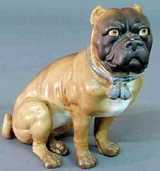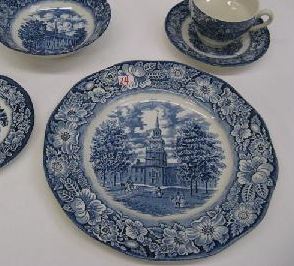Pricing Guides & Dictionary of Makers Marks for Antiques & Collectibles

Q&A ON RESEARCHING MARKS FOR:
STAFFORDSHIRE IRONSTONE - GERMAN PORCELAIN - STUDIO POTTERY - ROYAL VIENNA - PORCELAIN FIGURINES
See more examples
STAFFORDSHIRE IRONSTONE PLATE
You will find an example of this Registration Diamond under our "DIAMONDS, TRIANGLES etc" Shape Category, but the key to deciphering this symbol is on our "Dating British Ceramics" page through our EXTRA HELP section. When you use the tables on that page you will find that the design on this lovely plate was registered on February 10, but for some reason yours is missing the Year Code near the top. However, because the bottom tip in this Registration Diamond is a number, we know that it dates ca 1842 - 1867.
The company that produced this Plate is as noted below the mark, G. (or George) WOOLISCROFT, located in Hanley, Staffordshire. Although some resources date the operation of this company ca 1880s onwards and have them as producing mostly Tiles, the company that made your plate was a predecessor and was in operation only ca 1850 - 1854, which also dates your item. George Wooliscroft went on to become a partner in several Potteries thereafter and eventually founded a Ceramic Tiles company in 1880.
STUDIO POTTERY VASE
GERMAN PORCELAIN VASE
ROYAL VIENNA HAND-PAINTED VASE
GERMAN PORCELAIN DOG FIGURINE
However, in our opinion this is a recent Asian reproduction. Although we cannot be certain by just looking at a photograph, some of the reasons we believe this to be the case include the following observations:
1) We have only seen Schaller's mark in this format as hand-applied, not as a well defined backstamp. The horizontal line underneath is also a bit peculiar. 2) As you know, the Country of Origin notation was required on items made after 1891. Although it is in principle possible that this was made in 1882 - 1891, it is highly unlikely since there are no signs of aging whatsoever (crazing etc). 3) The overall workmanship seems to lack some of the detail you would expect on items made by this maker. It is fine enough, but just not up to the standards we would normally expect.
CLASSICAL GREEK PORCELAIN FIGURINE MARK
AMERICAN EARTHENWARE PITCHER
As a general tip or for future reference and because these marks look very much alike, the first thing we suggest to do is to recognize the two animals flanking the central Shield. This way you can eliminate most marks that are not of the same type, for example in your case there is a Lion and a Unicorn.
The next thing is to realize that the symbols in the center of the Shield between the two animals are usually initials when it comes to American companies. Once you train your eyes to concentrate on these, the next thing is to identify the actual details that differentiate your mark from others.
However, please note that many companies used several variations of these marks, so there may be some other differences, but the main symbols (animals and initials) should be the same. Especially the initials, are the most characteristic sign.
Using this technique, your pitcher is marked with logo for ETRURIA POTTERY [OTT & BREWER] and hence the initials O&B on the Shield. Please use our NAME SEARCH for OTT & BREWER to see other marks they also used and read a brief Fact Sheet on the company. Your lovely Earthenware Pitcher was made ca 1863 - 1893.
ARTS & CRAFTS AMERICAN STUDIO VASE
As you probably know, University City Pottery was founded by Edward Gardner Lewis, a wealthy local businessman and art lover, who was also the founder of the American Woman's League in 1907. In 1910 he invited several world famous Potters (Taxile Doat, Adelaide Alsop Robineau, Frederick Hurten Rhead and others) to teach Pottery & Art. Gardner's aim was to provide a venue for educating women of the time in business, languages, photography, art and pottery.
Unfortunately, this social "experiment" ended in early 1915 due to lack of funds, so all pieces attributed to this Pottery were made ca 1910 - 1915. Items not made or inspired by Gardner himself were rarely signed by the actual woman artist and there are no records as to the various names that attended these classes. However, some teaching master Potters also signed their pieces, for example Taxile Doat, but not always.
This is a fairly rare piece and you are very lucky to have it. It is not characteristic of their most common examples, which feature relief decoration and incised details on the body (also most glazes they used were matte). However, most pieces with shiny heavy glazes and lightly textured or crackled surfaces are usually attributed to Robineau and his pupils. You may also use our NAME SEARCH for University City Pottery to see an actual example, listed as No. 1 on the results page - note the right-top corner symbol on this image where the superimposed U&C letters show as they are marked on most pieces and in this format is practically identical to yours.
To use our huge database of Pottery & Porcelain marks, including marks on Ceramics of all types, please see our Ceramics Marks Identification service.
To find prices and determine values for your antiques & collectibles, including porcelain & pottery, please see our Antiques Price Guides with millions of examples of items sold at auction.


